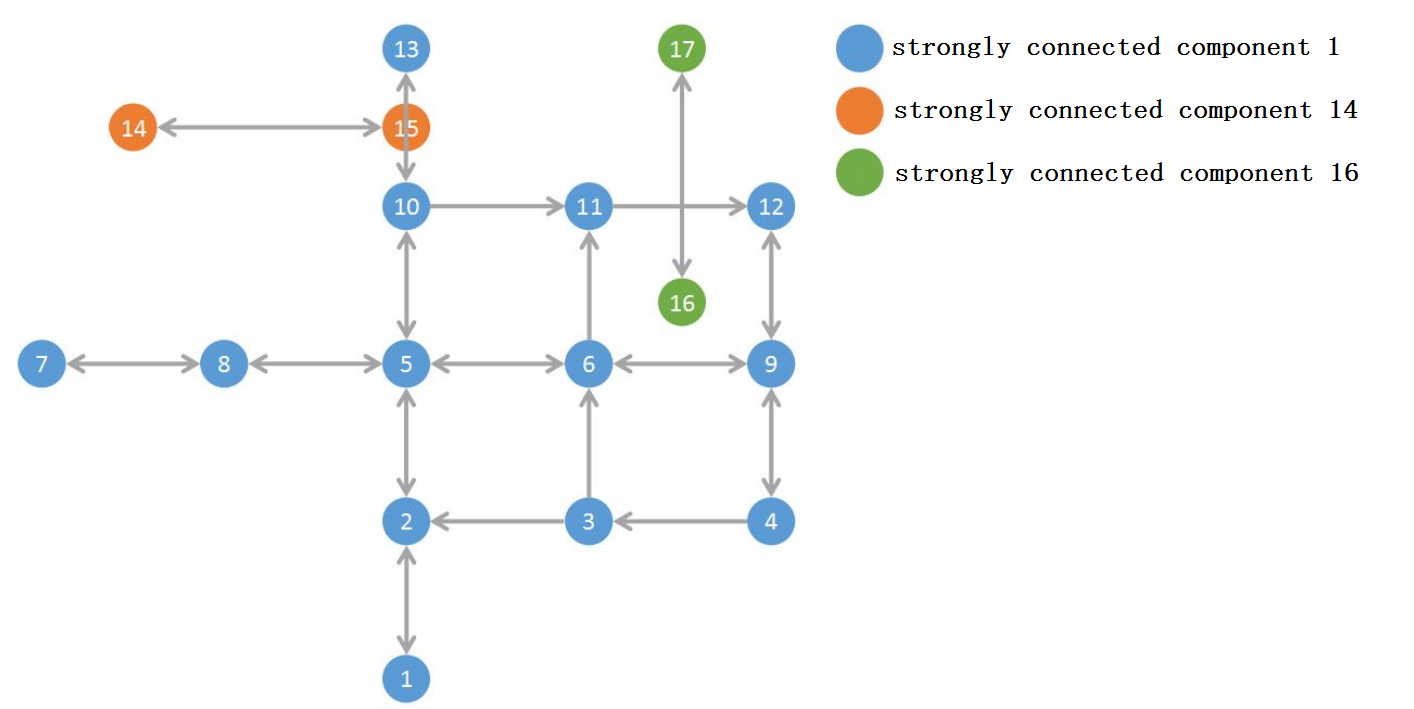pgr_strongComponents — Return the strongly connected components of a directed graph using Tarjan’s algorithm based on DFS.
In particular, the algorithm implemented by Boost.Graph.
Warning
Experimental functions
A strongly connected component of a directed graph is a set of vertices that are all reachable from each other. This implementation can only be used with a directed graph.
The main Characteristics are:
- Components are described by vertices
- The returned values are ordered:
- component ascending
- node ascending
- Running time: O(V+E)
pgr_strongComponents(edges_sql)
RETURNS SET OF (seq, component, n_seq, node)
OR EMPTY SET
The signature is for a directed graph.
| Example: |
|---|
SELECT * FROM pgr_strongComponents(
'SELECT id, source, target, cost, reverse_cost FROM edge_table'
);
seq | component | n_seq | node
-----+-----------+-------+------
1 | 1 | 1 | 1
2 | 1 | 2 | 2
3 | 1 | 3 | 3
4 | 1 | 4 | 4
5 | 1 | 5 | 5
6 | 1 | 6 | 6
7 | 1 | 7 | 7
8 | 1 | 8 | 8
9 | 1 | 9 | 9
10 | 1 | 10 | 10
11 | 1 | 11 | 11
12 | 1 | 12 | 12
13 | 1 | 13 | 13
14 | 14 | 1 | 14
15 | 14 | 2 | 15
16 | 16 | 1 | 16
17 | 16 | 2 | 17
(17 rows)

| edges_sql: | an SQL query, which should return a set of rows with the following columns: |
|---|
| Column | Type | Default | Description |
|---|---|---|---|
| id | ANY-INTEGER |
Identifier of the edge. | |
| source | ANY-INTEGER |
Identifier of the first end point vertex of the edge. | |
| target | ANY-INTEGER |
Identifier of the second end point vertex of the edge. | |
| cost | ANY-NUMERICAL |
Weight of the edge (source, target)
|
|
| reverse_cost | ANY-NUMERICAL |
-1 | Weight of the edge (target, source),
|
Where:
| ANY-INTEGER: | SMALLINT, INTEGER, BIGINT |
|---|---|
| ANY-NUMERICAL: | SMALLINT, INTEGER, BIGINT, REAL, FLOAT |
| Parameter | Type | Default | Description |
|---|---|---|---|
| edges_sql | TEXT |
SQL query as described above. |
Returns set of (seq, component, n_seq, node)
| Column | Type | Description |
|---|---|---|
| seq | INT |
Sequential value starting from 1. |
| component | BIGINT |
Component identifier. It is equal to the minimum node identifier in the component. |
| n_seq | INT |
It is a sequential value starting from 1 in a component. |
| node | BIGINT |
Identifier of the vertex. |
Indices and tables